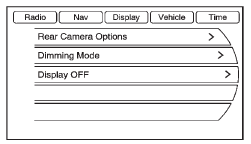Rear Vision Camera (RVC)
The vehicle may have a Rear Vision Camera (RVC) system. Read this entire section before using it.
The RVC can assist the driver when backing up by displaying a view of the area behind the vehicle.
WARNING
The RVC system does not display pedestrians, bicyclists, animals, or any other object located outside the camera's field of view, below the bumper, or under the vehicle.
Do not back the vehicle using only the RVC screen or by using the screen during longer, higher speed backing maneuvers, or where there could be cross-traffic. Perceived distances may be different from actual distances.
Failure to use proper care before backing may result in injury, death, or vehicle damage. Always check before backing by checking behind and around the vehicle.
An image appears on the radio screen with the message Check Surroundings for Safety when the vehicle is shifted into R (Reverse). The radio screen goes to the previous screen after approximately 10 seconds once the vehicle is shifted out of R (Reverse).
To cancel the delay, do one of the following:
○ Press a hard key on the navigation system.
○ Shift into P (Park).
○ Reach a vehicle speed of 8 km/h (5 mph).
Turning the Rear Vision Camera System On or Off
To turn the rear vision camera system on or off:
1. Shift into P (Park).
2. Press the CONFIG button.
3. Select Display.

4. Select Rear Camera Options.
5. Select Camera. When a check mark appears next to the Camera option, then the
RVC system is on.
See also:
Resetting the Power Folding Mirrors
Reset the power folding mirrors if:
• The mirrors are accidentally obstructed while folding.
• They are accidentally manually folded/unfolded.
• The mirrors vibrate at normal driving speeds.
...
DVD Display Error Messages
The DVD display error message depends on the radio that is in the vehicle. The video screen can display one of the following:
Disc Load/Eject Error: This message displays when there are disc load or ...
Under the Hood
GM's two-mode hybrid system enables "full" hybrid operation with the
capability to cruise on electric power up to 30 mph. The gas engine kicks in if
more acceleration is needed, as well ...





